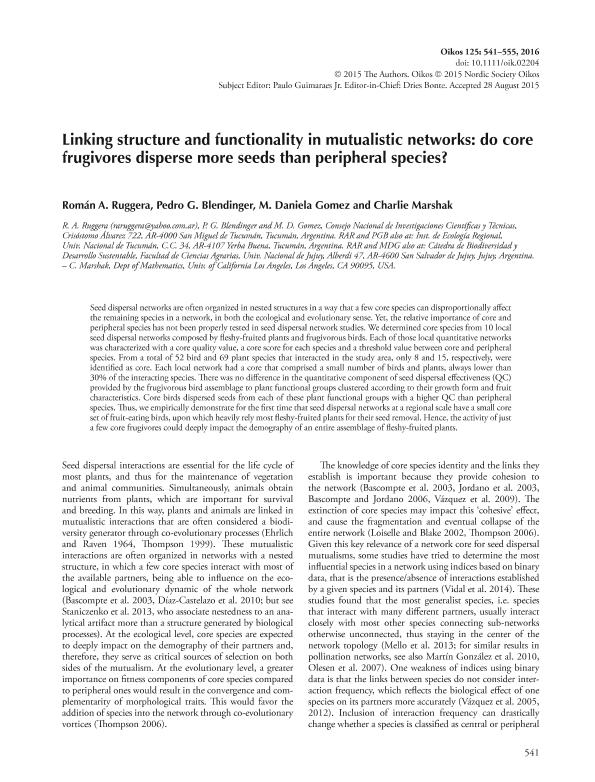Mostrar el registro sencillo del ítem
dc.contributor.author
Ruggera, Román Alberto

dc.contributor.author
Blendinger, Pedro Gerardo

dc.contributor.author
Gomez, Maria Daniela

dc.contributor.author
Marshak, Charlie
dc.date.available
2019-11-28T19:42:56Z
dc.date.issued
2016-04
dc.identifier.citation
Ruggera, Román Alberto; Blendinger, Pedro Gerardo; Gomez, Maria Daniela; Marshak, Charlie; Linking structure and functionality in mutualistic networks: Do core frugivores disperse more seeds than peripheral species?; Wiley Blackwell Publishing, Inc; Oikos; 125; 4; 4-2016; 541-555
dc.identifier.issn
0030-1299
dc.identifier.uri
http://hdl.handle.net/11336/90819
dc.description.abstract
Seed dispersal networks are often organized in nested structures in a way that a few core species can disproportionally affect the remaining species in a network, in both the ecological and evolutionary sense. Yet, the relative importance of core and peripheral species has not been properly tested in seed dispersal network studies. We determined core species from 10 local seed dispersal networks composed by fleshy-fruited plants and frugivorous birds. Each of those local quantitative networks was characterized with a core quality value, a core score for each species and a threshold value between core and peripheral species. From a total of 52 bird and 69 plant species that interacted in the study area, only 8 and 15, respectively, were identified as core. Each local network had a core that comprised a small number of birds and plants, always lower than 30% of the interacting species. There was no difference in the quantitative component of seed dispersal effectiveness (QC) provided by the frugivorous bird assemblage to plant functional groups clustered according to their growth form and fruit characteristics. Core birds dispersed seeds from each of these plant functional groups with a higher QC than peripheral species. Thus, we empirically demonstrate for the first time that seed dispersal networks at a regional scale have a small core set of fruit-eating birds, upon which heavily rely most fleshy-fruited plants for their seed removal. Hence, the activity of just a few core frugivores could deeply impact the demography of an entire assemblage of fleshy-fruited plants.
dc.format
application/pdf
dc.language.iso
eng
dc.publisher
Wiley Blackwell Publishing, Inc

dc.rights
info:eu-repo/semantics/openAccess
dc.rights.uri
https://creativecommons.org/licenses/by-nc-sa/2.5/ar/
dc.subject
FRUIT-FRUGIVORE MUTUALISM
dc.subject
CORE SPECIES
dc.subject
SEED DISPERSAL EFFECTIVENESS
dc.subject
INTERACTION NETWORKS
dc.subject.classification
Ecología

dc.subject.classification
Ciencias Biológicas

dc.subject.classification
CIENCIAS NATURALES Y EXACTAS

dc.title
Linking structure and functionality in mutualistic networks: Do core frugivores disperse more seeds than peripheral species?
dc.type
info:eu-repo/semantics/article
dc.type
info:ar-repo/semantics/artículo
dc.type
info:eu-repo/semantics/publishedVersion
dc.date.updated
2019-11-21T17:36:05Z
dc.journal.volume
125
dc.journal.number
4
dc.journal.pagination
541-555
dc.journal.pais
Reino Unido

dc.journal.ciudad
Londres
dc.description.fil
Fil: Ruggera, Román Alberto. Universidad Nacional de Jujuy; Argentina. Consejo Nacional de Investigaciones Científicas y Técnicas; Argentina. Universidad Nacional de Tucumán; Argentina
dc.description.fil
Fil: Blendinger, Pedro Gerardo. Consejo Nacional de Investigaciones Científicas y Técnicas; Argentina. Universidad Nacional de Tucumán; Argentina
dc.description.fil
Fil: Gomez, Maria Daniela. Universidad Nacional de Jujuy; Argentina. Consejo Nacional de Investigaciones Científicas y Técnicas; Argentina
dc.description.fil
Fil: Marshak, Charlie. University of California at Los Angeles; Estados Unidos
dc.journal.title
Oikos

dc.relation.alternativeid
info:eu-repo/semantics/altIdentifier/url/http://onlinelibrary.wiley.com/doi/10.1111/oik.02204
dc.relation.alternativeid
info:eu-repo/semantics/altIdentifier/doi/http://dx.doi.org/10.1111/oik.02204
Archivos asociados
